Role of Ni Layer Thickness in Regulating Mechanical Properties and Deformation-Fracture Behavior of TiB2-Ni Multilayer Films
Abstract
1. Introduction
2. Materials and Methods
2.1. Film Deposition
2.2. Film Characterization
3. Results
3.1. Microstructure
3.2. Mechanical Properties
4. Discussion
4.1. Interface
4.2. Analysis of Stress Conditions
4.3. Deformation and Fracture Mechanisms
4.4. Apparent Fracture Toughness and Crack Length Considerations
5. Conclusions
Author Contributions
Funding
Data Availability Statement
Conflicts of Interest
References
- Karvankova, P.; Veprek-Heijman, M.G.J.; Azinovic, D.; Veprek, S. Properties of superhard nc-TiN/a-BN and nc-TiN/a-BN/a-TiB2 nanocomposite coatings prepared by plasma induced chemical vapor deposition. Surf. Coat. Technol. 2006, 200, 2978–2989. [Google Scholar] [CrossRef]
- Arslan, E.; Totik, Y.; Celik, A.; Efeoglu, İ. Effect of annealing on adhesion of TiB2 films deposited by pulsed magnetron sputtering. Surf. Eng. 2010, 26, 567–570. [Google Scholar] [CrossRef]
- Grancic, B.; Mikula, M.; Hruba, L. The Influence of Deposition Parameters on TiB2 Thin Films Prepared by Magnetron Sputtering. Vacuum 2005, 80, 174–177. [Google Scholar] [CrossRef]
- Pelleg, J.; Sade, G.; Sinder, M.; Mogilyanski, D. Compositional and structural changes in TiB2 films induced by bias, in situ and post-deposition annealing, respectively. Phys. B Condens. Matter. 2006, 381, 118–127. [Google Scholar]
- Jing, L.; Kong, F.; Xu, J.; Fernandes, F.; Evaristo, M.; Dong, S.; Cavaleiro, A.; Ju, H. Deciphering the mechanical strengthening mechanism: Soft metal doping in ceramic matrices-A case study of TiN-Ag films. Mater. Des. 2024, 248, 113489. [Google Scholar]
- Luan, J.; Wang, L.; Xu, J.; Ma, B.; Dong, S.; Ju, H. Insights into tribological performances of magnetron-sputtered Si-BCN films in air and seawater conditions. Ceram. Int. 2025, 51, 14553–14564. [Google Scholar] [CrossRef]
- Ding, J.C.; Lee, D.; Mei, H.; Zhang, T.F.; Kang, M.C.; Wang, Q.M.; Kim, K.H. Influence of Si addition on structure properties of TiB2-Si nanocomposite coatings deposited by high-power im and pulse magnetron sputtering. Ceram. Int. 2019, 45, 6363–6372. [Google Scholar] [CrossRef]
- Ding, J.C.; Zhang, T.F.; Yun, J.M.; Kim, K.H.; Wang, Q.M. Effect of Cu addition on the microstructure and properties of TiB2 films deposited by a hybrid system combining high power impulse magnetron sputtering and pulsed DC magnetron sputtering. Surf. Coat. Technol. 2018, 344, 441–448. [Google Scholar] [CrossRef]
- Wang, H.Y.; Wang, B.; Li, S.Z.; Xue, Q.J.; Huang, F. Toughening magnetron sputtered TiB2 coatings by Ni addition. Surf. Coat. Technol. 2013, 232, 767–774. [Google Scholar] [CrossRef]
- Ju, H.B.; Zhou, R.; Luan, J.; Yu, L.H.; Xu, J.H.; Zuo, B.; Yang, J.F.; Geng, Y.X.; Zhao, L.J. Multilayer Mo2N-Ag/SiNx films for demanding applications: Structure and temperature-cycling tribological properties. Mater. Des. 2022, 223, 111128. [Google Scholar] [CrossRef]
- Ju, H.; Luan, J.; Xu, J.; Cavaleiro, A.; Evaristo, M.; Fernandes, F. Nano-multilavered ZrN-Ag/Mo-SN film design for stable anti-frictional performance at a wide range of temperatures. Friction 2024, 12, 2826–2837. [Google Scholar] [CrossRef]
- Wolfe, D.E.; Singh, J.; Narasimhan, K. Synthesis and characterization of multilayered TiC/TiB, coatings deposited by ion beam assisted, electron beam-physical vapor deposition (EB-PVD). Surf. Coat. Technol. 2003, 165, 8–25. [Google Scholar] [CrossRef]
- He, D.; Li, X.; Pu, J.; Wang, L.; Zhang, G.; Lu, Z.; Li, W.; Xue, Q. Improving the mechanical and tribological properties of TiB2/a-C nanomultilayers by structural optimization. Ceram. Int. 2018, 44, 3356–3363. [Google Scholar] [CrossRef]
- Ranade, A.N.; Krishna, L.R.; Li, Z.; Wang, J.; Korach, C.S.; Chung, Y.W. Relationship between hardness and fracture toughness in Ti-TiB2 nanocomposite coatings. Surf. Coat. Technol. 2012, 213, 26–32. [Google Scholar] [CrossRef]
- Oliver, W.C.; Pharr, G.M. An improved technique for determining hardness and elastic modulus using load and displacement sensing indentation experiments. J. Mater. Res. 2011, 7, 1564–1583. [Google Scholar] [CrossRef]
- Smolik, J.; Kacprzyńska-Golacka, J.; Sowa, S.; Piasek, A. The analysis of resistance to brittle cracking of tungsten doped TiB2 coatings obtained by magnetron sputtering. Coatings 2020, 10, 807. [Google Scholar] [CrossRef]
- Cai, X.; Xu, Y.; Zhong, L.; Liu, M. Fracture toughness of WC-Fe cermet in W-WC-Fe composite by nanoindentation. J. Alloys. Compd. 2017, 728, 788–796. [Google Scholar] [CrossRef]
- Misra, A.; Thilly, L. Structural metals at extremes. Mater. Today 2011, 13, 54–64. [Google Scholar]
- Musil, J. Hard nanocomposite coatings: Thermal stability, oxidation resistance and toughness. Surf. Coat. Technol. 2012, 207, 50–65. [Google Scholar] [CrossRef]
- Hainsworth, S.V.; Page, T.F. The nanoindentation response of systems with thin hard carbon coatings. Mater. Res. Sot. Spmp. Proc. 1996, 436, 171–176. [Google Scholar] [CrossRef]
- Korsunsky, A.M.; McGurk, M.R.; Bull, S.J.; Page, T.F. On the hardness of coated systems. Surf. Coat. Technol. 1998, 99, 171–183. [Google Scholar] [CrossRef]
- Xi, L.X.; Kaban, I.; Nowak, R.; Bruzda, G.; Sobczak, N.; Eckert, J. Wetting, reactivity, and phase formation at interfaces between Ni-Al melts and TiB2 ultrahigh-temperature ceramic. J. Am. Ceram. Soc. 2018, 101, 911–918. [Google Scholar] [CrossRef]
- Wang, M.; Wang, D.; Kups, T.; Schaaf, P. Size effect on mechanical behavior of Al/Si3N4 multilayers by nanoindentation. Mater. Sci. Eng. A 2015, 644, 275–283. [Google Scholar] [CrossRef]
- Wang, J.; Misra, A. Strain hardening in nanolayered thin films. Curr. Opin. Solid State Mater. Sci. 2014, 18, 19–28. [Google Scholar] [CrossRef]
- Shetty, D.K.; Wright, I.G.; Mincer, P.N.; Clauer, A.H. Measurement of the fracture toughness of ceramics using a sharp-indenter crack-length meth. J. Mater. Sci. 1985, 20, 1873–1882. [Google Scholar] [CrossRef]
- Lankford, J. Indentation micro fracture in the Palmqvist crackregime: Implications for fracture toughness evaluation by the indentation method. J. Mater. Sci. 1982, 493–495. [Google Scholar]
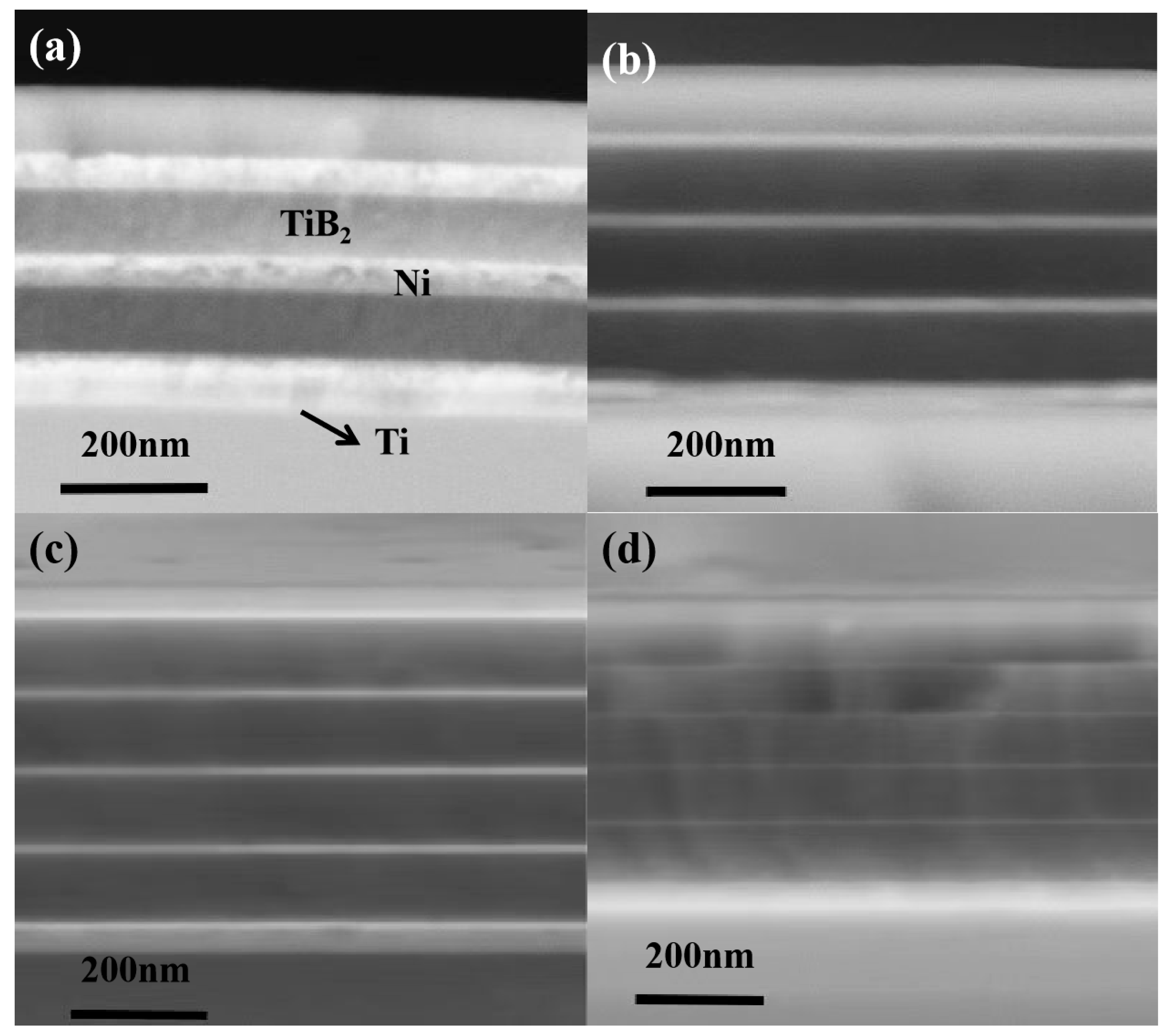
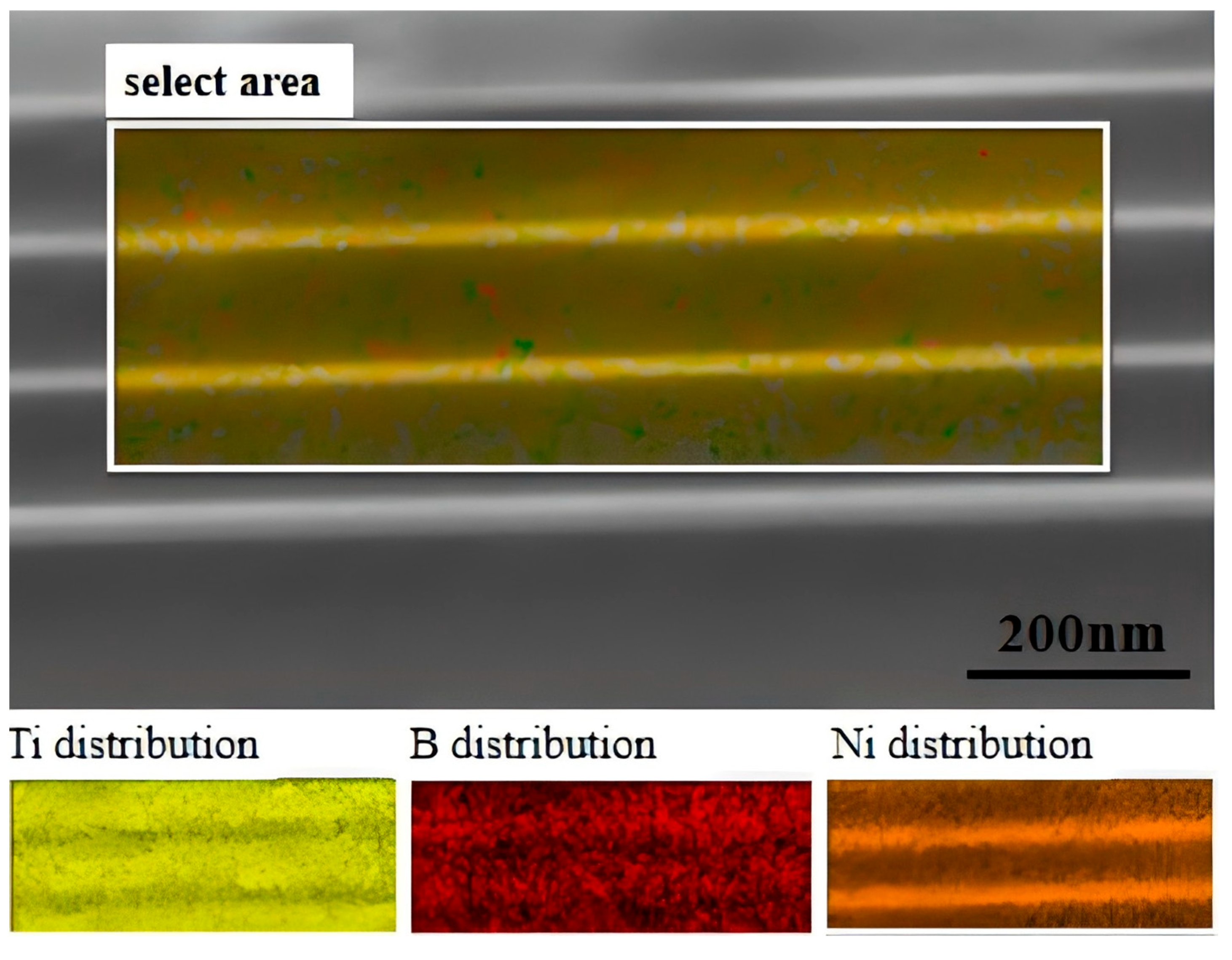

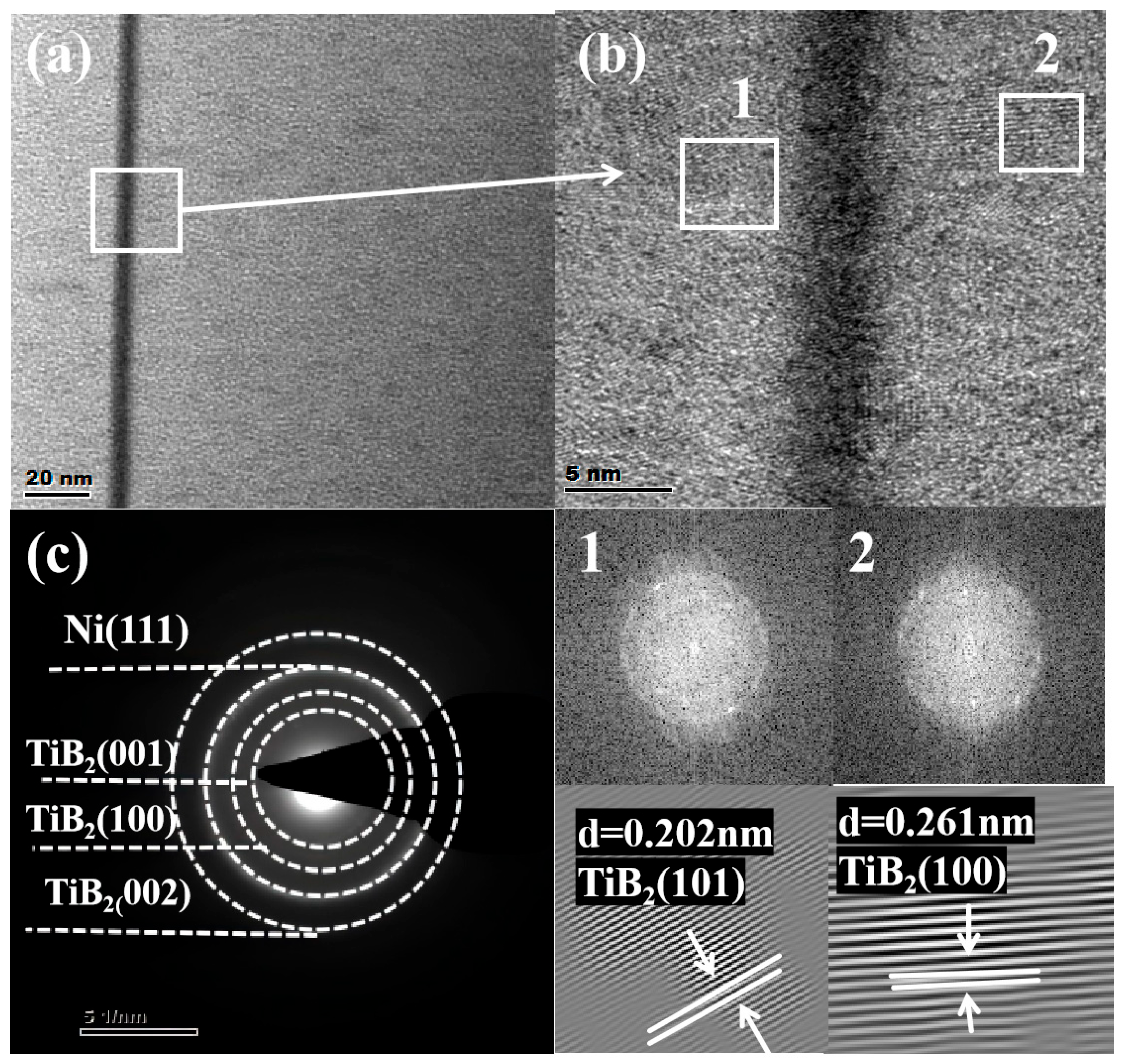


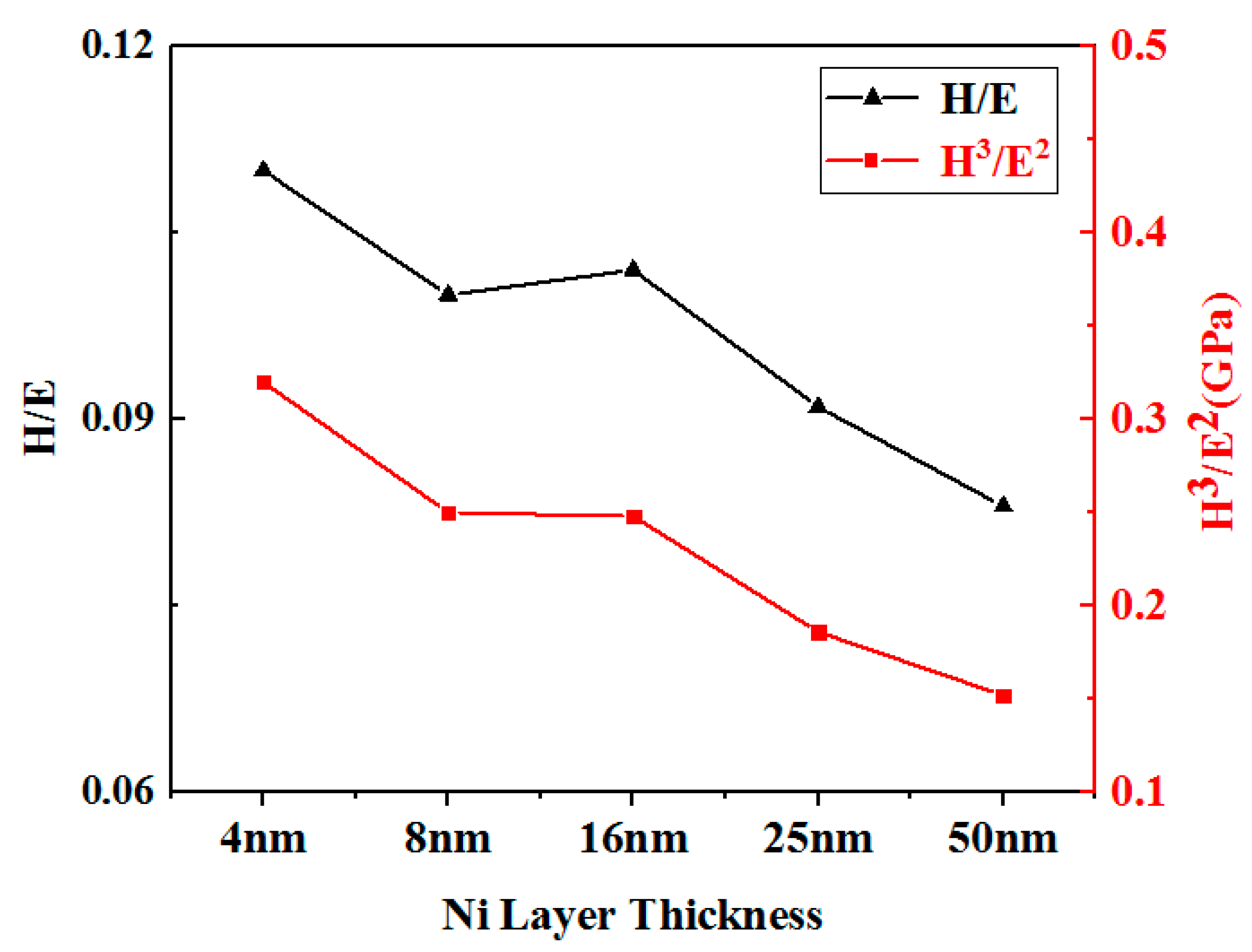
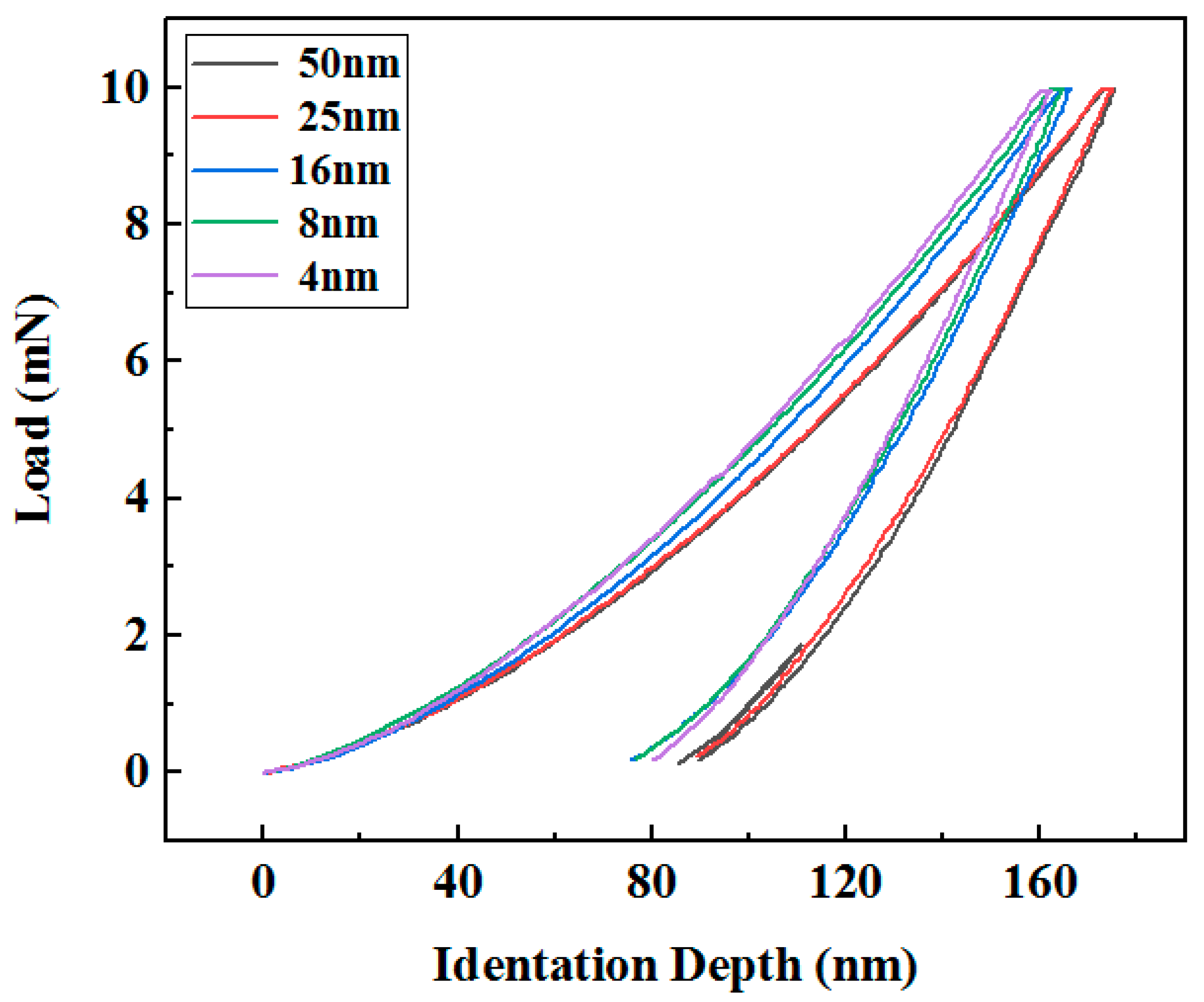

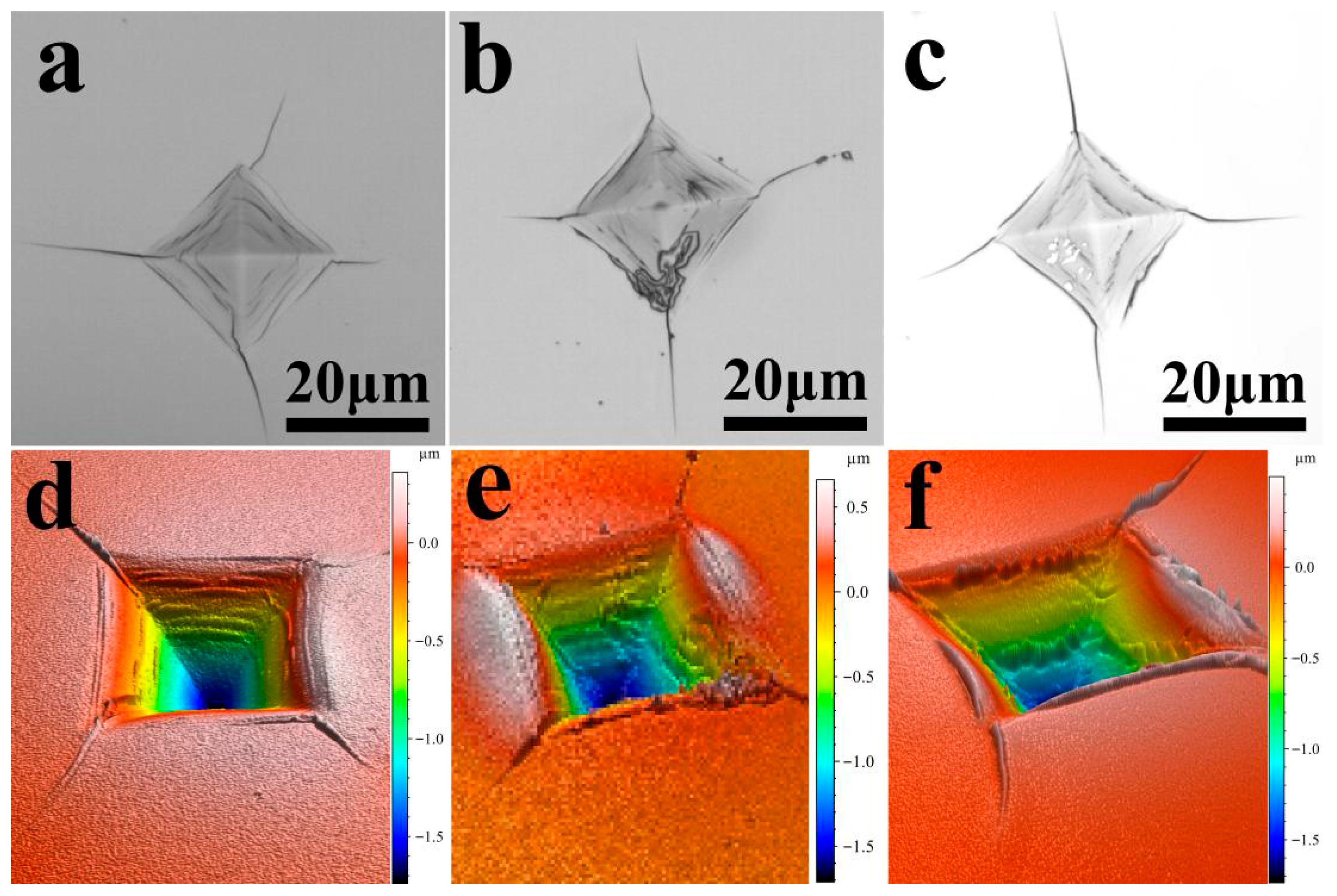



| Deposition Time of Ni/min | Deposition Time of TiB2/min | Thickness of Ni Layer/nm | Thickness of TiB2 Layer/nm | Number of TiB2-Ni Layers | Total Thickness/nm |
|---|---|---|---|---|---|
| 10 | 10 | 50 | 100 | 3 | 450 |
| 5 | 10 | 25 | 100 | 4 | 500 |
| 2.5 | 10 | 16 | 100 | 4 | 470 |
| 1 | 10 | 8 | 100 | 5 | 540 |
| 0.5 | 10 | 4 | 100 | 5 | 520 |
| Ni Layer Thickness (nm) | E (GPa) | H (GPa) | P (mN) | a (μm) | l (μm) | c (μm) | KIC (MPa·m1/2) |
|---|---|---|---|---|---|---|---|
| 4 | 247.9 | 27.3 | 2000 | 10.85 | 9.90 | 20.57 | 1.54 |
| 8 | 255.2 | 25.6 | 2000 | 11.03 | 9.59 | 20.62 | 1.70 |
| 16 | 242.7 | 24.4 | 2000 | 11.05 | 10.38 | 21.43 | 1.54 |
| 25 | 236.4 | 21.8 | 2000 | 8.64 | 7.58 | 16.22 | 2.56 |
| 50 | 228.6 | 19.3 | 2000 | 9 | 7.47 | 16.47 | 2.73 |
Disclaimer/Publisher’s Note: The statements, opinions and data contained in all publications are solely those of the individual author(s) and contributor(s) and not of MDPI and/or the editor(s). MDPI and/or the editor(s) disclaim responsibility for any injury to people or property resulting from any ideas, methods, instructions or products referred to in the content. |
© 2025 by the authors. Licensee MDPI, Basel, Switzerland. This article is an open access article distributed under the terms and conditions of the Creative Commons Attribution (CC BY) license (https://creativecommons.org/licenses/by/4.0/).
Share and Cite
Qi, X.; Wang, X.; Tang, L.; Maimaititaji, R.; Shi, M.; Ding, S.; Ma, J.; Xu, H.; Fan, J.; Shang, H.; et al. Role of Ni Layer Thickness in Regulating Mechanical Properties and Deformation-Fracture Behavior of TiB2-Ni Multilayer Films. Nanomaterials 2025, 15, 1687. https://doi.org/10.3390/nano15221687
Qi X, Wang X, Tang L, Maimaititaji R, Shi M, Ding S, Ma J, Xu H, Fan J, Shang H, et al. Role of Ni Layer Thickness in Regulating Mechanical Properties and Deformation-Fracture Behavior of TiB2-Ni Multilayer Films. Nanomaterials. 2025; 15(22):1687. https://doi.org/10.3390/nano15221687
Chicago/Turabian StyleQi, Xiaoben, Xu Wang, Lina Tang, Rukeye Maimaititaji, Miaoling Shi, Sinan Ding, Jianyuan Ma, Huanqing Xu, Jinyi Fan, Hailong Shang, and et al. 2025. "Role of Ni Layer Thickness in Regulating Mechanical Properties and Deformation-Fracture Behavior of TiB2-Ni Multilayer Films" Nanomaterials 15, no. 22: 1687. https://doi.org/10.3390/nano15221687
APA StyleQi, X., Wang, X., Tang, L., Maimaititaji, R., Shi, M., Ding, S., Ma, J., Xu, H., Fan, J., Shang, H., & Wang, Y. (2025). Role of Ni Layer Thickness in Regulating Mechanical Properties and Deformation-Fracture Behavior of TiB2-Ni Multilayer Films. Nanomaterials, 15(22), 1687. https://doi.org/10.3390/nano15221687






